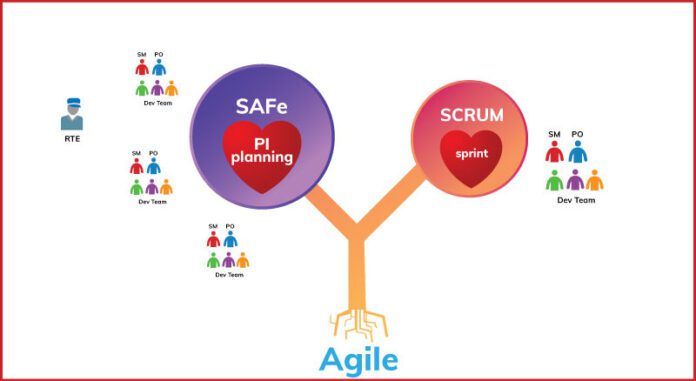Agile project management has revolutionized software development, offering a spectrum of strategies to tailor approaches to specific needs. A pivotal choice for many organizations lies in the decision between Scrum and the Scaled Agile Framework (SAFe). Understanding the intricacies of each framework is crucial for aligning organizational goals with the right Agile methodology.
I. Unveiling Scrum
A. Overview
Agile project management has emerged as a transformative force within software development circles, offering organizations the flexibility to tailor their approaches according to unique needs and strengths. At the forefront of this Agile revolution are two prominent frameworks: Scrum and the Scaled Agile Framework (SAFe). Before delving into the distinctions between them, it’s crucial to establish a comprehensive overview of both methodologies.
1. Agile’s Flexibility: A Paradigm Shift
Agile, as a project management philosophy, represents a paradigm shift from traditional, rigid methodologies. Its allure lies in the adaptability it provides, enabling organizations to respond swiftly to changing requirements, customer feedback, and evolving market dynamics. Unlike traditional “waterfall” methodologies, where development occurs sequentially, Agile embraces an iterative and incremental approach.
2. Scrum: Agile at the Team Level
Scrum, a popular Agile framework, operates at the team level. It emphasizes the formation of small, self-organized teams capable of delivering high-quality software rapidly. The essence of Scrum lies in simplicity, fostering teams that remain adaptable to stakeholder input and market demands. By breaking down large projects into manageable steps, Scrum ensures continuous improvement and responsiveness.
3. SAFe: Scaling Agile for Enterprises
SAFe (Scaled Agile Framework) transcends the simplicity of Scrum, addressing the needs of larger enterprises with interconnected teams. While Scrum focuses on narrow objectives and small teams, SAFe orchestrates a comprehensive approach. It coordinates multiple teams, aligning their efforts to deliver products that might be too large or complex for Scrum’s individualized focus.
B. Key Components of Scrum
- Product Owners: Align team goals with customer expectations, providing valuable feedback on product requirements.
- Scrum Masters: Oversee teams and processes, ensuring a smooth development journey by eliminating obstacles.
- Scrum Teams: The boots-on-the-ground force, actively engaged in building the product in collaboration with Product Owners and Scrum Masters.
C. Pros and Cons of Scrum
Pros:
- Optimized development processes.
- Focus on end-user preferences.
- Swift delivery timelines.
- Seamless coordination within small, self-contained teams.
Cons:
- Challenges in scaling for larger projects.
- Mandates team-wide training.
- Dev cycles may not always align with project deadlines.
D. Ideal Scenarios for Scrum Adoption
- Frequent input from stakeholders.
- Changing deliverables requiring adaptability.
- Short turnaround times for delivering high-quality products.
II. Decoding SAFe
A. Overview
The Scaled Agile Framework (SAFe) transcends the simplicity of Scrum, aiming to help organizations set and achieve objectives while meeting customer demands. Unlike Scrum, SAFe operates on a larger, more interconnected scale.
B. Core Tenets of SAFe
- Lean Product Development: Optimizes processes, reducing waste and ensuring cost-effective approaches.
- Agile Software Development: Involves incremental changes to accommodate feedback and evolving demands.
- System Thinking: Takes a holistic approach to development, considering the entire system and its interconnected parts.
C. Pros and Cons of SAFe
Pros:
- Enhances agility and competitiveness for businesses.
- Facilitates increased cooperation between teams.
- Implements barriers to prevent product issues.
- Improves operations at an enterprise level.
Cons:
- Less suitable for small businesses and startups.
- Requires teams to learn a shared Agile language.
- Rigid, top-down framework.
D. Ideal Scenarios for SAFe Adoption
- Organizations overseeing multiple interconnected teams.
- Preference for a top-down leadership approach.
- Handling complex projects that demand collaboration across teams.
III. Contrasting Scrum and SAFe
A. Organization Structure
- Scrum: Ideal for small organizations with independent teams.
- SAFe: Suited for enterprises with interconnected teams.
B. Development Philosophy
- Scrum: Focused on fast, continuous development.
- SAFe: Goal setting with organizational commitment.
C. Implementation
- Scrum: Implemented by small teams with straightforward goals.
- SAFe: Adopted by organizations tackling complex projects across multiple teams.
D. Processes
- Scrum: Lightweight, flexible, and iterative software delivery.
- SAFe: Clear objectives set with a predetermined schedule.
E. Framework Requirements
- Scrum: Embraced by a whole team.
- SAFe: Demands the commitment of an entire organization.
F. Team Roles
- Scrum: Less than 12 members with distinct roles.
- SAFe: Involves dozens of employees working across several roles.
G. Dependencies
- Scrum: Relies on coordination within teams.
- SAFe: Requires alignment between teams.
H. Timeframe
- Scrum: Sprints lasting one to four weeks.
- SAFe: Sprints lasting about two weeks.
IV. Choosing the Best Framework for Your Team
The decision between Scrum and SAFe hinges on various factors tailored to an organization’s unique context. Consider the following aspects to make an informed choice:
A. Organization Structure
- Scrum: Small organizations or independent teams.
- SAFe: Larger enterprises with interconnected teams.
B. Development Philosophy
- Scrum: Small team cohesion on projects with straightforward goals.
- SAFe: Coordination of the entire organization, emphasizing stability and structure.
C. Implementation Strategy
- Scrum: Ideal for small teams operating cohesively.
- SAFe: Unifies the entire organization, requiring cooperation between teams.
D. Processes
- Scrum: Adaptable, lightweight methods with regular assessments.
- SAFe: More formalized roles and processes, ensuring quality production and cooperation.
E. Framework Requirements
- Scrum: Requires commitment from a single team.
- SAFe: Demands organizational commitment and shared goals.
F. Team Roles and Structure
- Scrum: Small teams with defined roles (Product Owner, Scrum Master, Scrum Team).
- SAFe: Involves multiple teams with diverse roles like Release Train Engineers, Program Managers, and Solution Architects.
G. Team Dependencies
- Scrum: Teams can self-organize and manage work independently.
- SAFe: Requires coordination between multiple teams, leading to increased dependencies.
H. Timeframe
- Both frameworks operate within sprints, with varying cycle lengths:
- Scrum: Sprints last one to four weeks.
- SAFe: Sprints last about two weeks.
V. Similarities Between Scrum and SAFe
While Scrum and SAFe present distinct frameworks, they share fundamental similarities rooted in Agile principles:
- Team-based development with coordinated efforts.
- Incremental approaches to high-quality deliveries.
- Cooperation with stakeholders for feedback and adjustments.
- Regular inspection and adaptation strategies.
- Utilization of timeboxing for effective time management.
- Implementation of continuous delivery pipelines for frequent software updates.
VI. Scrum@Scale: Reaching for the Best of Both Worlds
In an attempt to address Scrum’s limitations in scalability, some organizations turn to Scrum@Scale. This approach borrows elements from SAFe, creating a central, interchangeable team that connects various groups and developers. Scrum@Scale extends the benefits of Scrum to larger organizations, offering an alternative to choosing between Scrum@Scale and SAFe.
In conclusion, the choice between Scrum and SAFe is a pivotal decision influencing an organization’s Agile journey. Understanding the nuances, strengths, and weaknesses of each framework empowers teams to align their Agile practices with organizational goals, ensuring a seamless and effective development process.










